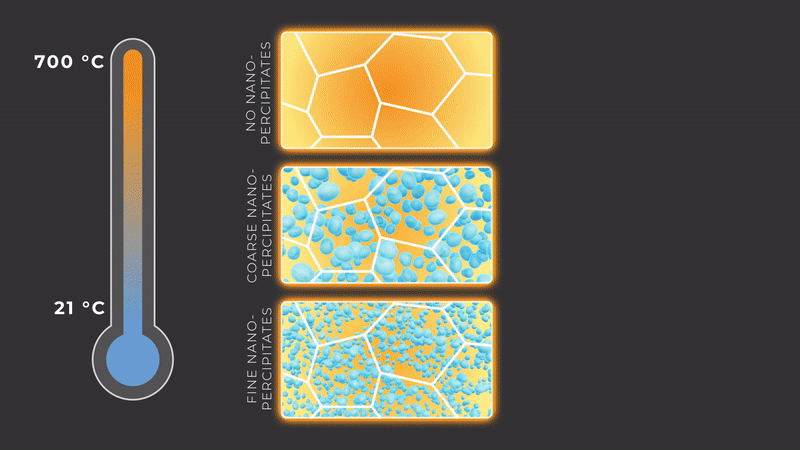Tiny But Mighty Precipitates Toughen a Structural Alloy

Mechanical properties, such as strength and ductility, can be tailored by adding nanoprecipitates, represented above by blue orbs, to a phase-transformable alloy and tuning their sizes and spacings. Credit: Michelle Lehman/ORNL, U.S. Dept. of Energy
Scientists at the Department of Energy’s Oak Ridge National Laboratory and the University of Tennessee, Knoxville, have found a way to simultaneously increase the strength and ductility of an alloy by introducing tiny precipitates into its matrix and tuning their size and spacing. The precipitates are solids that separate from the metal mixture as the alloy cools. The results, published in the journal Nature, will open new avenues for advancing structural materials.
Ductility is a measure of a material’s ability to undergo permanent deformation without breaking. It determines, among other things, how much a material can elongate before fracturing and whether that fracturing will be graceful or catastrophic. The higher the strength and ductility, the tougher the material.
“A holy grail of structural materials has long been, how do you simultaneously enhance strength and ductility?” said Easo George, principal investigator of the study and Governor’s Chair for Advanced Alloy Theory and Development at ORNL and UT. “Defeating the strength–ductility trade-off will enable a new generation of lightweight, strong, damage-tolerant materials.”
If structural materials could become stronger and more ductile, components of cars, planes, power plants, buildings and bridges could be built using less material. Lighter-weight vehicles would be more energy-efficient to make and operate, and tougher infrastructure would be more resilient.
Co-principal investigator Ying Yang of ORNL conceived and led the Nature study. Guided by computational thermodynamics simulations, she designed and custom-made model alloys with the special ability to undergo a phase transformation from a face-centered cubic, or FCC, to a body-centered cubic, or BCC, crystal structure, driven by changes in either temperature or stress.
“We put nanoprecipitates into a transformable matrix and carefully controlled their attributes, which in turn controlled when and how the matrix transformed,” Yang said. “In this material, we intentionally induced the matrix to have the capability to undergo a phase transformation.”
Continue reading at ORNL
Contact
Dawn Levy (levyd@ornl.gov, 865-576-6448)